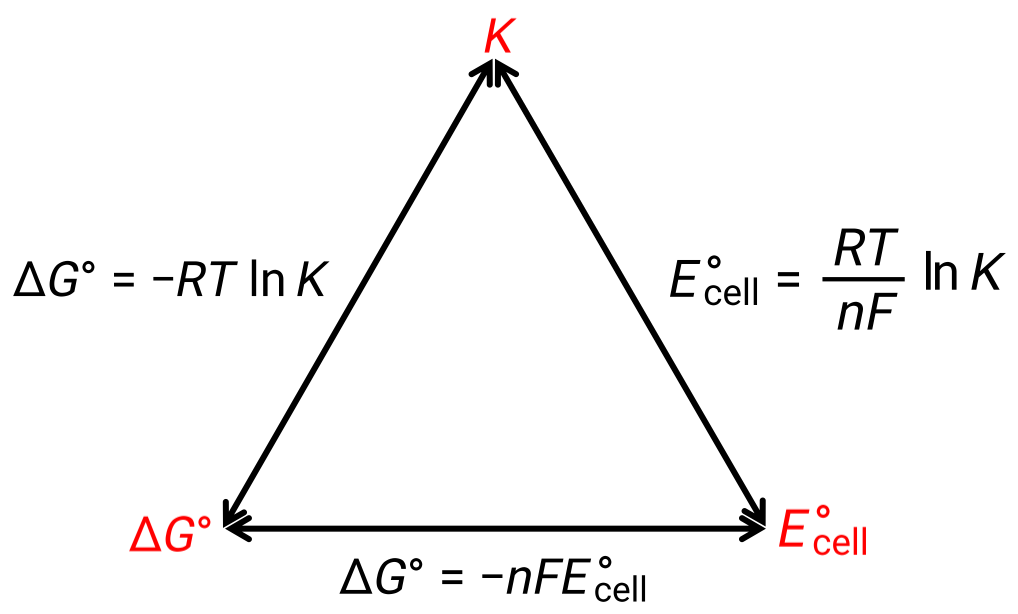18.5:
Cell Potential and Free Energy
The standard cell potential indicates a redox reaction’s spontaneity, so does the change in standard Gibbs free energy for a reaction. As both terms are a measure of reaction spontaneity, are they related to each other?
In a zinc-copper galvanic cell, the cell potential of 1.10 volts causes an electron flow, which is the maximum electrical work done by the cell. wmax is measured in joules and is expressed as the product of the total charge transferred in coulombs and the cell potential in volts.
The total charge, q, depends on n, the number of moles of electrons transferred during the reaction. In the zinc-copper galvanic cell, 2 moles of electrons are transferred from zinc to copper, so n = 2. To get the total charge, N is multiplied by Faraday’s constant, which is the magnitude of electric charge present in 1 mole of electrons: 96,485 coulombs.
Thus, the maximum electrical work performed by the zinc-copper galvanic cell is determined from the moles of electrons, Faraday’s constant, and the cell potential.
Here, all the energy for the electrical work is supplied by the cell itself, resulting in the system performing work on the surroundings which is denoted by a negative sign.
Recall that Gibbs free energy is associated with a reaction’s energy available to perform work. Under standard-state conditions, the change in Gibbs free energy is a measure of the highest amount of work generated in a reaction.
Thus, the maximum work can be substituted with ΔG, allowing the free energy change of an electrochemical reaction to be determined.
For the zinc-copper reaction, ΔG is −212 kilojoules, indicating that it is spontaneous. In comparison, a nickel-manganese redox reaction with a standard cell potential of −0.93 volts yields a value of +179 kilojoules, indicating that it is nonspontaneous.
The standard free energy change is also related to the equilibrium constant, K. A large equilibrium constant indicates that the reaction lies to the product side correlating with a negative ΔG value, and vice versa.
Given their relation to ΔG, the standard cell potential and equilibrium constant are also related. This relationship is derived by solving this equation for the cell potential and substituting ΔG with the gas constant, temperature, and the natural log of K.
18.5:
Cell Potential and Free Energy
Thermodynamics of a Redox Reaction
Thermodynamics is the branch of physics dealing with the relationship between heat and other forms of energy. In an electrochemical cell, chemical energy is converted into electrical energy.
Thus, a link can be predicted between cell potential, free energy change, and the equilibrium constant for the reaction. Cell potential can also be measured as the oxidant or the reducing strength, and similar acid-base strength measures are reflected in equilibrium constants.
Gibbs’ Free Energy and the Relationship Between E°cell and ΔG°
The Gibbs free energy is a quantity used to calculate the maximum amount of reversible work performed by a thermodynamic system maintained at constant temperature and pressure conditions. It is denoted by the symbol G, and its change is represented as ∆G. The standard free energy change of a system, ΔG°, is defined as the maximum work performed by a system, wmax. For a redox reaction occurring within a galvanic cell under standard conditions, all the work done is associated with electron transferring from the reducing agent to the oxidizing agent, welec. Thus,

However, any work associated with electron transfer depends on the charge transferred in Coulombs as well as the cell potential:

where n = the number of moles of transferred electrons, F is Faraday’s constant, which represents the coulombic charge of 1 mole of electrons, and E°cell is the standard cell potential. The relation between ΔG° and ΔE°cell confirms the sign conventions and the criteria for reaction spontaneity. Spontaneous redox reactions have positive potential and negative values of free energy.
Relationship between E°cell and K
The standard free energy change ΔG° is related to the equilibrium constant K of a redox reaction as follows:

Combining a previously derived relation between ΔG° and K and the equation relating to ΔG° and E°cell yields the following:

Therefore,

This equation indicates that redox reactions with large or positive standard cell potentials will proceed towards completion, reaching equilibrium when most reactants have been converted to product.
Nonspontaneous reactions or reactions proceeding in reverse directions exhibit negative cell potentials, positive free energy values, and an equilibrium constant of less than one. An equilibrium constant of one and cell potential and free energy values equal to zero is associated with a reaction under equilibrium at standard conditions.
The relationship between the cell potential under standard conditions and the thermodynamic constants ΔG° and K can be explained by the figure given below:

Figure 1: Graphic depicting the relation between three important thermodynamic properties.
This text is adapted from Openstax,Chemistry 2e, Section 17.4: Potential, Free Energy, and Equilibrium.
